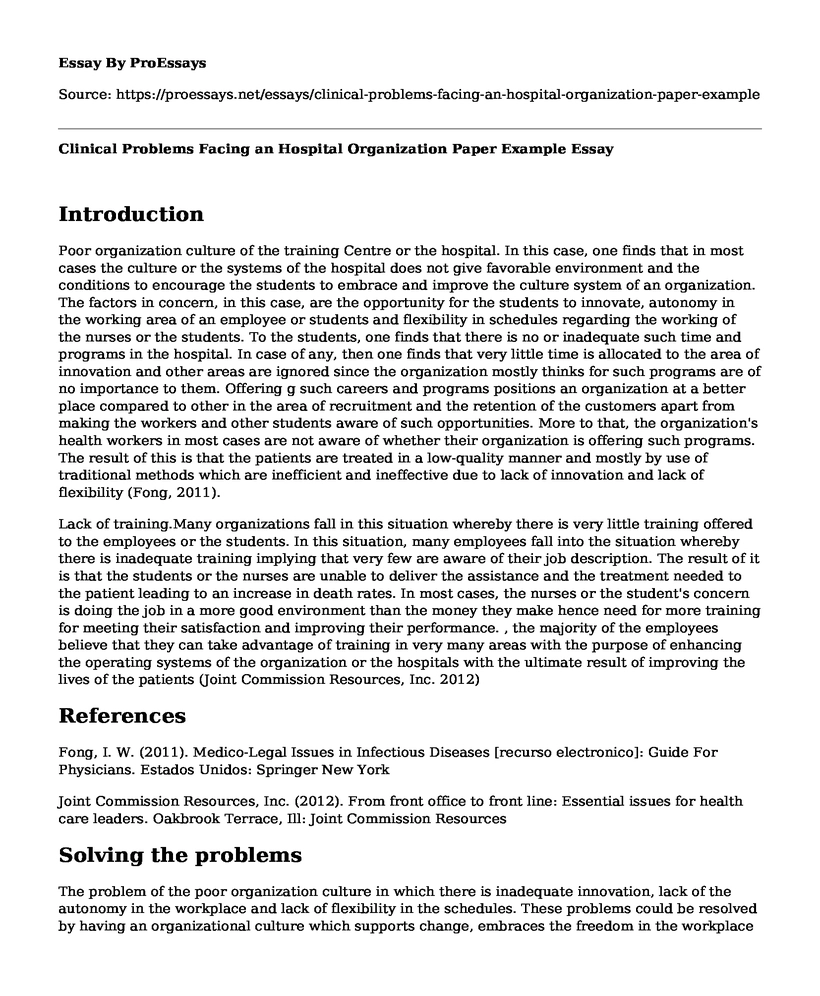Introduction
Poor organization culture of the training Centre or the hospital. In this case, one finds that in most cases the culture or the systems of the hospital does not give favorable environment and the conditions to encourage the students to embrace and improve the culture system of an organization. The factors in concern, in this case, are the opportunity for the students to innovate, autonomy in the working area of an employee or students and flexibility in schedules regarding the working of the nurses or the students. To the students, one finds that there is no or inadequate such time and programs in the hospital. In case of any, then one finds that very little time is allocated to the area of innovation and other areas are ignored since the organization mostly thinks for such programs are of no importance to them. Offering g such careers and programs positions an organization at a better place compared to other in the area of recruitment and the retention of the customers apart from making the workers and other students aware of such opportunities. More to that, the organization's health workers in most cases are not aware of whether their organization is offering such programs. The result of this is that the patients are treated in a low-quality manner and mostly by use of traditional methods which are inefficient and ineffective due to lack of innovation and lack of flexibility (Fong, 2011).
Lack of training.Many organizations fall in this situation whereby there is very little training offered to the employees or the students. In this situation, many employees fall into the situation whereby there is inadequate training implying that very few are aware of their job description. The result of it is that the students or the nurses are unable to deliver the assistance and the treatment needed to the patient leading to an increase in death rates. In most cases, the nurses or the student's concern is doing the job in a more good environment than the money they make hence need for more training for meeting their satisfaction and improving their performance. , the majority of the employees believe that they can take advantage of training in very many areas with the purpose of enhancing the operating systems of the organization or the hospitals with the ultimate result of improving the lives of the patients (Joint Commission Resources, Inc. 2012)
References
Fong, I. W. (2011). Medico-Legal Issues in Infectious Diseases [recurso electronico]: Guide For Physicians. Estados Unidos: Springer New York
Joint Commission Resources, Inc. (2012). From front office to front line: Essential issues for health care leaders. Oakbrook Terrace, Ill: Joint Commission Resources
Solving the problems
The problem of the poor organization culture in which there is inadequate innovation, lack of the autonomy in the workplace and lack of flexibility in the schedules. These problems could be resolved by having an organizational culture which supports change, embraces the freedom in the workplace and embraces the flexibility of the program. The first step in achieving this is establishing a system whereby the workers or the students are free and can interact as they communicate their views and ideas concerning the working of the organization. Through this interaction, the student who has an idea can which can lead to the improvement of the working system is encouraged to share it with others. This can take place through the students' liaising with leaders and sharing which leads to the reduction of tension such that they can communicate their views freely without fear but respect. By doing this then the organization and the students can be in a situation whereby they can freely innovate, and flexibility to develop the ideas by working in different environments and conditions (Guerra, N. S. 2015).
Lack of training
Mechanisms should be applied whereby there is training need assessment for the students nursing. In this case, the first step is to ensure that there is no shortage of nurses to avoid implicating the whole issue. Then it should be the responsibility of the physician or any other hired professional nurse to take the students through a training process to meet the needs of the clients. The management can enhance this through assessing the field in which the knowledge is limited than mobilizing the resources to facilitate the trainingmanagement. Out side training through workshops and visiting improved hospitals which has quality training equipment can also be done to expand their knowledge and broaden their expertise. The ultimate result in this case is the patient attraction and retention through offering the sound treatment that they deserve (Hughes, Seymour, Turner, Shahdad & Nohl, 2012).
References
Guerra, N. S. (2015). Clinical problem solving: Case management.
Hughes, F. J., Seymour, P. K. G., Turner, W., Shahdad, S., & Nohl, F. (2012). Clinical Problem Solving in Periodontology and Implantology - E-Book
Cite this page
Clinical Problems Facing an Hospital Organization Paper Example. (2022, Aug 01). Retrieved from https://proessays.net/essays/clinical-problems-facing-an-hospital-organization-paper-example
If you are the original author of this essay and no longer wish to have it published on the ProEssays website, please click below to request its removal:
- Overweight and Obesity: A National Epidemic Essay
- Assignment Example on Leadership Traits, Behaviors and Styles
- The Effects of Vitamin C Deficiency - Research Paper
- Case Study on Urinary Tract Infections
- Bias in Family Nurse Practitioner (FNP) Paper Example
- Essay Sample on Kidney Stones: A Common Problem among People Worldwide
- Essay on HR Learning and Development: Crafting a Culture for Growth







